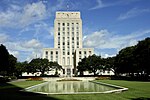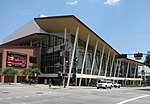Spirit of the Confederacy
1908 establishments in Texas1908 sculpturesBronze sculptures in TexasConfederate States of America monuments and memorials in TexasMonuments and memorials in the United States removed during the George Floyd protests ... and 7 more
Outdoor sculptures in HoustonRelocated buildings and structures in TexasSculptures of angelsSculptures of men in TexasStatues in TexasStatues removed in 2020United Daughters of the Confederacy monuments and memorials

Spirit of the Confederacy, also known as the Confederacy Monument, is an outdoor bronze sculpture depicting an angel holding a sword and palm branch by Louis Amateis, installed in Houston's Sam Houston Park, in the U.S. state of Texas. It was erected in 1908 by a local chapter of the United Daughters of the Confederacy. The statue was removed from the park in 2020 and relocated to the Houston Museum of African American Culture.
Excerpt from the Wikipedia article Spirit of the Confederacy (License: CC BY-SA 3.0, Authors, Images).Spirit of the Confederacy
Allen Parkway, Houston
Geographical coordinates (GPS) Address Nearby Places Show on map
Geographical coordinates (GPS)
| Latitude | Longitude |
|---|---|
| N 29.76028 ° | E -95.37261 ° |
Address
Allen Parkway
Allen Parkway
77002 Houston
United States
Open on Google Maps







